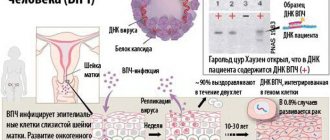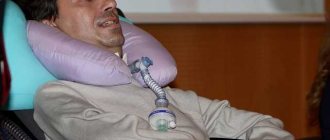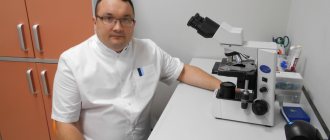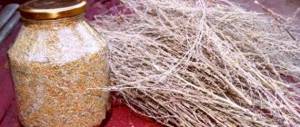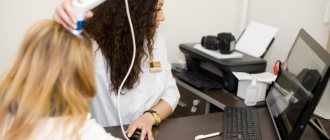De Quervain's disease (tenosynovitis) is a syndrome characterized by inflammation of the tendons of the thumb .
With this disease, friction occurs between the swollen tendons and their sheaths against the narrow tunnel in which they move, resulting in pain in the base of the first finger.
To understand the process, we will briefly describe the anatomy of hand movements.
Contraction of the muscles of the forearm provides flexion and extension of the fingers. The transmission of muscle contraction to the fingers and their movement is carried out by the tendons of the flexor and extensor muscles.
The tendons of the flexor muscles pass to the fingers through the palmar surface of the hand, and the extensor muscles through the dorsum.
The tendons are held in the desired position on the hand by the transverse ligaments. On the back of the hand is the dorsal ligament. Each group of tendons in the dorsal carpal ligament is in a separate canal.
For example, in the first fibrous canal there are tendons that go to the first finger of the hand.
Since the thumb is actively involved in many manipulations, such as grasping and holding various objects in the hand, its tendons experience significant stress.
Simply put, de Quervain's tenosynovitis causes inflammation of the ligaments, swelling and thickening. As a result, the channel for the ligament becomes too small, symptoms of the disease arise, and the function of the entire hand is impaired.
Where are the true causes of the syndrome?
There is no exact cause that causes tenosynovitis.
However, it is believed that activities that involve constant, repetitive movements of the arms, such as golfing, gardening, or carrying a child, can worsen the condition.
Therefore, this disease is sometimes called abroad “gamer’s thumb” or “mother’s wrist.”
Possible causes of the disease:
- hand injuries, since as a result of injuries, scar tissue is formed that can limit the movement of the tendon;
- inflammatory diseases of the joints;
- constant load on the wrist joint.
Risk factors
ATTENTION!
People between the ages of 30 and 50 are at greatest risk of developing the pathology, mostly women. This may be due to pregnancy and caring for a newborn, and repeated lifting of the child.
Signs of illness
De Quervain's disease has characteristic symptoms:
- pain at the attachment point of the base of the thumb;
- swelling at the base of the thumb;
- Difficulty moving the wrist when performing everyday activities;
- the pain intensifies when pressing on the affected area.
The main symptom is pain in the wrist joint when pressing on the base of the first finger of the hand, this is especially evident when trying to hold an object in the hand.
In the initial stages of the disease, pain appears only when the thumb is forcibly extended and when sudden and intense movements of the hand are made.
Over time, the pain becomes constant or occurs even with the slightest movements.
The pain may radiate to the hand, shoulder, forearm and neck area. Sometimes the pain spreads along the back of the thumb to its tip.
Sometimes night pain occurs when, during sleep, some awkward movement causes a sharp pain in the hand. Patients are also characterized by reduced grip strength on an object with the affected hand.
If the syndrome is not treated for a long time, the pain may spread to the forearm. Any movement that requires the participation of the thumb will cause pain, which leads to decreased ability to work.
You can find out what set of treatment procedures should be performed if the patient has a fracture of the scaphoid bone in our material.
If you decide to use the Nanoplast Forte patch, instructions for use, pros and cons, as well as reviews from doctors and patients will be very helpful to you.
Why does the disease develop?
The tendon of the first finger of the hand, to which the extensor muscle is attached, runs in a separate narrow osteo-fibrous canal along with blood vessels and nerves. Due to the fact that the thumb performs many different tasks (minor operations, grasping, fixing objects), its ligaments and tendons experience constant stress. As a result, microdamage, inflammation and swelling of these structures develop. The already narrow channel becomes small for the movements of thickened ligaments. Compression of the neurovascular bundle occurs and the entire function of the hand is disrupted.
The disease was described at the beginning of the twentieth century by surgeon Franz de Quervain, but still does not lose its relevance. This is a fairly common disease that traumatologists and orthopedists classify as professional. It is found among professions that are forced to perform constant and similar work with the hands:
- dressmakers, ironers;
- painters and finishers;
- surgeons;
- musicians;
Often de Quervain's disease affects women who do housework, carry children in their arms, and do gardening. Currently, the disease is also observed in office workers who work with a computer mouse.
Experts associate the development of the pathological process with hormonal changes in women, with trauma to the hand, and with rheumatoid arthritis.
Diagnostic techniques
Diagnosis of the disease is based on samples and tests:
- Filkenstein test. The first finger of the hand is squeezed inside the fist and the hand is abducted in the direction of the little finger or thumb.
If sharp pain occurs in the wrist joint on the side of the first finger when the hand is abducted, the test is considered positive. The photo shows a test to check for de Quervain's disease - Tense abduction test. When pressing from the back side on the thumb of the hand so that the finger is brought to the palm, on the sore side, even with slight pressure on the finger, a sharp pain will occur, and the finger will be brought to the palm practically without resistance, and on the healthy hand the finger will be vigorously resist pressure.
- Testing the ability to hold objects using the thumb. The patient tries to hold an object between the thumb and index finger with the sick and healthy hand. When you try to pull a held object, it becomes clear that the affected hand holds the object much weaker. When trying to hold an object removed from the affected hand, a sharp pain occurs in the wrist joint in the area of the thumb.
- X-ray examination. In the initial stages of the disease, x-rays reveal a twofold thickening of the soft tissues. With a long course of the disease, signs of changes in the bone and periosteum in the wrist joint in the area of the thumb are visible.
De Quervain's disease
In 1895, de Quervain described a disease now known under several names: de Quervain's disease, stenosing tenosynovitis, chronic tenosynovitis, styloiditis, stenosing ligamentitis of the dorsal carpal ligament, ligamentitis of the first fibro-osseous extensor canal 1 (large) finger of the hand. But the most commonly used, shorter and well-known name is de Quervain's disease.
As was said on the pages of our website, all ligamentites are associated with one or another ligament of the human body. De Quervain's disease is no exception. To understand the occurrence and clinical manifestations of the disease, let us turn to anatomy.
rice. #1 Dorsal carpal ligament
The dorsal carpal ligament begins on the inner surface of the ulna, at its distal end, and attaches to the outer surface of the radius at the same level. The ligament is a compacted aponeurosis, from the inner surface of which fascial septa extend towards the distal ends of the radius and ulna and the proximal row of carpal bones. These fascial partitions divide the space between the dorsal transverse ligament and the bones into 6 channels through which muscle tendons pass in isolation from each other. Fig. No. 2
Rice. No. 2 with a yellow and red pointer marks the 1st channel, which plays a major role in the formation of De Quervain’s disease. Dark probes indicate the other 5 extensor canals. The tendons of the long abductor muscle of the first finger (m. abductor pollicis longus) and its short extensor (i.e. extensor pollicis brevis) pass through the first canal of the dorsal ligament of the wrist. The tendons of the abductor longus muscle of the first finger and its short extensor muscle lie in a groove on the dorsolateral surface of the radius. These tendons are covered with a loose membrane rich in blood vessels. The dorsal carpal ligament turns the groove into an osteofibrous canal. Drawings No. 3
Rice. 3 Numbers 1 indicate the tendon of the long abductor muscle of the first finger (m. abductor pollicis longus) and number 2 indicates the short extensor muscle of the first finger (m. extensor pollicis brevis). So. De Quervain's disease is a stenotic ligamentitis of the osteofibrous carpal tunnel. With this type of ligamentitis, the tendons in the first canal of the dorsal carpal ligament become inflamed. Because of this, a narrowing of the canal occurs, which provokes the development of pain during tendon sliding. This pathology is much more common in women than in men.
(De Quervain's disease) - occurs as a result of an inflammatory process of the canal through which the extensor tendon of the first finger of the hand passes. The disease is manifested by the presence of pain and swelling in the projection of the styloid process of the radius, figure No. 4, extension of the first finger is painful, movements are limited and are accompanied by clicking.
Fig.4 The area of the styloid process of the radius is marked with arrows in the photo.
Causes of De Quervain's Disease
An accurate understanding of the etiology, i.e. There is no reason for this disease. The main reason that causes inflammation is considered to be increased stress on 1 finger:
- as a result of frequently repeated movements of the thumb associated with the patient’s professional activities.
- the birth of a child and caring for him, there is a need to load the hands (rock, bathe the baby, etc.)
- long-term unusual work (hand washing - the machine broke down, weeding the garden, etc.)
Activities that involve constant, repetitive movements of the arms, whether golfing, gardening, or carrying a baby, can worsen the condition. Therefore, this disease is sometimes called abroad “gamer’s thumb” or “mother’s wrist.”
Symptoms of De Quervain's disease
- Pain and swelling in the area of the wrist joint (styloid process of the radius and base of the 1st finger).
- Pain occurs during extension and abduction of the thumb, as well as with direct pressure on the area of the anatomical snuffbox (anatomical depression - a fossa in the area of the wrist joint near the styloid process of the radius)
- You can hear a creak in the canal when you move one finger; this is the friction of the tendons against the walls of the narrowed and inflamed canal.
- Movement of the first finger is limited.
- Pain in the wrist joint.
- Pain when moving the first finger
- Loss of ulnar deviation of the hand, i.e. abduction of the hand to the ulnar side
Diagnosis of De Quervain's disease
Of the non-instrumental tests that are used to diagnose De Quervain's disease, the Finkelstein test and the test described by Eichhoff are used. The essence of these tests is as follows: the doctor grabs the thumb and bends it as much as possible, or asks the patient to clench his fist so that the first finger is covered by the three-phalanx fingers and move the hand (deviation) to the ulnar side. If acute pain occurs in the area of the first canal, the styloid process of the radius, at the base of the first finger, then the test is considered positive. Fig. No. 5
Fig. No. 5
Testing the ability to hold objects using the thumb. The patient tries to hold an object between the thumb and index finger with the sick and healthy hand. When you try to pull a held object, it becomes clear that the affected hand holds the object much weaker. When trying to hold an object removed from the affected hand, a sharp pain occurs in the wrist joint in the area of the thumb.
Instrumental diagnostic methods:
- X-ray examination. In the initial stages of the disease, x-rays reveal a twofold thickening of the soft tissues. With a long course of the disease, signs of changes in the bone and periosteum in the wrist joint in the area of the thumb are visible.
- Ultrasound examination (ultrasound) will give a picture of the anatomical state of the ligaments and tendons involved in the pathological process of the disease (the thickness of the tendons, their abrasion, tears, as well as inflammation of the sheaths of the tendon sheaths, synovitis)
- Magnetic resonance imaging is an informative but expensive method, therefore it is used mainly to exclude other diseases in controversial cases.
Treatment of De Quervain's disease
Conservative treatment: effective only at an early stage (no later than 6-8 weeks from the moment the first signs of the disease appear).
First of all, eliminating physical activity.
Immobilization is performed - using a plaster cast applied from the fingertips to the middle of the forearm or modern orthoses and braces that limit movement in 1 finger and wrist joint. Rice. No. 6
Fig. No. 6
Refusal of physical activity and immobilization prevent further injury and aggravation of the condition.
Over the next two to three weeks, along with fixation, it is necessary to carry out adequate conservative therapy for the disease.
The disease is based on an inflammatory process, so physiotherapeutic procedures, anti-inflammatory drugs and novocaine blockades are used for treatment.
Nonsteroidal anti-inflammatory drugs NSAIDs or NSAIDs reduce swelling and pain. But they can only be taken as prescribed by a doctor, after examination and examination. Since any drugs have contraindications.
Injections of steroidal anti-inflammatory drugs - blockades: This reduces signs of inflammation, pain and swelling for a long time. The drug is injected directly into the site of inflammation. Surgical treatment: Used when conservative treatments for de Quervain's disease do not help and the pain interferes with the patient's daily life. During the operation, a small access is made to the modified ligament of the 1st osteofibrous canal, which covers the tendons. The upper wall of the canal is excised, thereby achieving decompression (increasing the clearance for the sliding of compressed tendons) of the tendons. This naturally reduces pain and inflammation so that the tendons can move freely in the canal.
If the syndrome is not treated for a long time, the pain may spread to the forearm. Any movement that requires the participation of the thumb will cause pain, which leads to decreased ability to work.
In an advanced form of the disease, there is a sharp narrowing of the canal of the extensor tendons of the first finger. Inflammation and severe pain can lead to persistent limitation, dysfunction of flexion and extension of the finger - contracture. The friction of the tendons against the ligaments of the compressive canal can cause a violation of their integrity and rupture of the tendons.
If clinical symptoms or simply pain in the area of the hand and wrist joint appear, consult a specialist. Take care of yourself and your hands!!!
You can make an appointment:
tel. +7
Schedule:
- Monday-Friday from 9.00 to 19.00
- Saturday from 10.00 to 16.00
Healing procedures
Treatment of de Quervain's syndrome is possible conservatively and surgically.
Conservative treatment
First of all, patients stop doing physical activity.
The affected ligament is immobilized so that the first finger is in a bent position and located opposite the second and third fingers, the hand itself should be slightly bent to the back.
Therefore, for immobilization, a plaster cast is used, applied from the fingertips to the middle of the forearm.
Refusal of physical activity and immobilization prevent further injury to the joint, but this is not a cure.
Over the next two to three weeks of keeping the arm in a plaster cast, it is necessary to carry out adequate conservative therapy for the disease.
The basis of the disease is the inflammatory process of the ligament , therefore, physiotherapeutic procedures, anti-inflammatory drugs and novocaine blockades are used to treat the tendons.
However, these remedies are not very effective for long-term disease, and quite often after a short period of remission the disease occurs again.
Local injections of hydrocortisone have a good anti-inflammatory effect; they are administered two to six times with a break of two to three days.
Conservative treatment is always followed by a rehabilitation period lasting from two to four weeks.
Surgical treatment of pathology
If conservative treatment is ineffective, surgical treatment of de Quervain's disease is often resorted to. For bilateral lesions, surgical treatment is also indicated.
The operation can also be performed on an outpatient basis using local anesthesia. During the operation, the ligamentous canal is dissected and the tendon compression is released.
Preventive measures
To reduce the likelihood of the syndrome occurring, it is necessary to reduce physical activity associated with repetitive twisting and grasping movements of the hand.
Orthopedic diseases are characterized not only by limited range of motion in the joints, but also by serious pain. Often it is pain that forces patients to seek treatment for the disease in any available way.
De Quervain's disease is a disease that is associated with severe symptoms of pain and limited activity. This disease was described by the doctor Fritz de Quervain at the end of the 19th century in Switzerland.
IT IS IMPORTANT TO KNOW! The only remedy for JOINT PAIN, arthritis, arthrosis, osteochondrosis and other diseases of the musculoskeletal system, recommended by doctors! ...
Main reasons
The exact causes of the disease still remain unknown. However, many years of medical observations prove that it is predominantly professional in nature. With the same type of movements and increased load on the thumb, the pathological process can only worsen. Dressmakers and massage therapists, painters, surgeons and musicians are at risk.
The appearance of the disorder may be preceded by acute or chronic tendon injuries. These include bruises, sprains and other injuries. This reason is not common. It accounts for only 5% of pathology cases.
De Quervain's disease is often diagnosed in young mothers who carry their children by the armpits. Hands, and especially thumbs, constantly experience unnatural tension. Approximately 7% of women suffer from grandmother's ligamentitis. They play with their grandchildren and constantly expose their hands to similar stress.
Causes
De Quervain's disease is a process that in medical terminology is called stenosing tenosynovitis. In this condition, the tendons of the abductor longus and extensor pollicis brevis muscles are compressed by the narrowing synovial receptacle.
De Quervain's disease affects the first (thumb) finger of the hand and only the 2 muscles listed above. They are enclosed in a common shell of synovial tissue, which can decrease in volume due to chronic inflammation.
Factors in the development of de Quervain's disease are:
- Thumb injuries.
- Hereditary predisposition.
- Infections in the area of the synovial sheaths of the hand.
- Congenital pathological processes in connective tissue.
- Rheumatological diseases.
- A certain type of activity associated with the load on this finger - among milkmaids, pianists, mechanics, seamstresses, laundresses, painters, winders.
De Quervain's disease can develop under the influence of one or more of the listed factors, which often aggravate each other.
Prevention
The occurrence of a disease such as stenosing tenosynovitis is not easy to prevent. This is due to the characteristics of human labor.
If you perform regular work that places stress on your thumb, or if you have a family history of the disease, you should:
- Take breaks from working so that the muscles of the thumb are not subjected to excessive stress.
- Do not expose the brush to injury or cold exposure.
- Perform training exercises and warm-up for the hand before doing work.
- Undergo regular preventive examinations with a doctor.
Timely detection of symptoms of the disease allows one to avoid severe events and maintain the quality of life of patients.
It can be useful:
- Symptoms and treatment of rheumatism in children
- Osteopenia of the spine and femoral neck
- What to do if your joints, back and lower abdomen hurt during menopause?
- Chest pain when coughing: causes and treatment
- Treatment of periarthritis of the knee joint
Development mechanism
To understand how to treat a disease, you need to understand the mechanism of the pathological process.
The disease is based on a process called tenosynovitis (tenosynovitis) - inflammation of the synovial vagina. This element is a channel, a container for the muscles of the thumb, along which they slide and perform their work smoothly and painlessly.
When exposed to the factors listed above, inflammation begins in the tendon area. The body replaces the damaged tissue with scar tissue, and the volume of the tendon sheath decreases. The canal narrows, and its walls compress the tendon elements.
At this point, tenosynovitis leads to the transfer of inflammation to the muscle tendons. Their work is disrupted and severe pain occurs.
Symptoms
The symptoms of de Quervain's disease are quite typical and allow a preliminary diagnosis to be made. It is not difficult to understand them, knowing the mechanism of development of the disease, because any symptoms are a consequence of pathological phenomena.
The syndrome includes the following clinical manifestations:
- The process begins with pain at the base of the thumb. Often patients indicate pain in the area of the styloid process of the radius.
- The pain radiates (spreads) along the length of the thumb. Less commonly, there is irradiation from the forearm to the elbow joint.
- Symptoms of inflammation occur - tissue swelling, redness of the skin over the synovial space.
- Symptoms worsen when trying to move. It is especially painful to press the first finger against the palm and bend it.
- When moving there is a feeling of clicking or crepitation. Associated with the difficulty of muscle passage through a narrow channel.
- Pain and swelling are detected upon palpation along the tendon sheath.
The listed symptoms are quite specific, this allows us to correctly assume the diagnosis. The syndrome requires timely treatment, while the tendons are not yet damaged by the walls of the narrow canal.
If you find yourself with the listed symptoms of de Quervain's disease, you need to consult an orthopedic doctor as soon as possible.
Diagnosis of pathology
During the examination, the doctor compares 2 hands. This allows you to identify minor but absolute manifestations of the disease. Upon palpation of the affected area, compaction of the synovial vagina and smoothing of the anatomical snuffbox are noted. When pressed, moderate pain appears. The skin is not changed, there is no hyperemia.
The Finkelstein test is used to diagnose tenosynovitis. The patient is asked to clench the hand into a fist, while placing the thumb inside, and move it towards the elbow. At this time, you can hear a characteristic click. This is due to the fact that the inflamed tendons rub against the walls of the canal. If movement is accompanied by severe pain, the test is considered positive.
The diagnosis is confirmed based on history and examination. More often than not, no additional research is required. In doubtful cases, to exclude arthritis or other inflammatory diseases, a direct radiography or magnetic resonance imaging (MRI) of the wrist joint is performed. X-rays show swelling and thickening of the soft tissue in the area of the first extensor canal.
Diagnostics
Stenosing tenosynovitis syndrome is a favorable disease in terms of diagnosis. Doctors can help confirm the presence of de Quervain's disease by:
- Collection of complaints - subjective symptoms are often quite typical.
- Anamnesis of the disease and life - the detection of predisposing factors and family history of the disease allows us to reliably predict the diagnosis.
- Inspection of the hand and its palpation. The doctor will detect characteristic tissue swelling and soreness.
- A thickened dorsal ligament can be felt in the canal area, deviation of the fingers is accompanied by severe pain, the range of motion of the thumb is reduced - these signs are diagnostic criteria for de Quervain's syndrome.
- The Finkelstein test is specific. The patient bends the thumb and presses it tightly with the other fingers of this hand. After this, the arm is moved outward. A sharp pain syndrome occurs.
- Impaired holding of objects by the thumb also indicates muscle damage in the tendon sheath.
Instrumental studies are not informative for de Quervain's syndrome. In addition, these procedures are not required to make a reliable diagnosis.
Features of differential diagnosis
After a physical examination and x-ray examination, the question often arises about the advisability of differential diagnosis. The disease described in the article has a similar clinical picture to other ailments. These are primarily rheumatoid infection, deforming arthrosis, neuralgia and nonspecific polyarthritis. Therefore, during diagnosis, it is advisable to pay attention to the following factors that fully characterize de Quervain’s disease (tenosynovitis):
- The pathology is several times more common among the fair sex, which is due to the narrowness of the dorsal ligament canal.
- The peak development of the disease occurs at the age of 50-60 years. However, over the past few years she has become “younger”. Now this diagnosis is increasingly being heard by women and men under 40 years of age.
- As a rule, the pathological process spreads to the right hand. This trend is explained by the fact that it is this limb that performs the majority of work actions.
After differential diagnosis, the doctor can prescribe treatment and also give recommendations for preventing relapses.
Treatment
Therapy of any orthopedic disease is complex and complex. It is impossible to eliminate the disease by taking one pill or giving an injection. During treatment, conservative and surgical methods are used:
- The effect of medications on the symptoms of the disease.
- Physiotherapy.
- Balneo- and mud therapy.
- Massage.
- Physiotherapy.
- Surgical intervention.
Separately, it is worth mentioning treatment with folk remedies. This method is not approved by most qualified doctors, since traditional recipes do not have an evidence base. However, for many patients, folk remedies can reduce the symptoms of the disease.
Attempts to self-treat the disease may lead to complications or progression of the disease.
Full medical care should be provided by an orthopedist or traumatologist who will prescribe comprehensive treatment for the disease.
Conservative treatment
If no more than one and a half months have passed since the onset of the disease, conservative methods of therapy are quite sufficient to eliminate the pathological process. Old stenosing tenosynovitis already requires surgery, but even in this case, conservative methods are used as auxiliary ones.
Methods of conservative therapy:
- Non-steroidal anti-inflammatory drugs. They are used in the form of tablets, local gels and ointments, less often in the form of injections. These drugs reduce the symptoms of the disease, eliminate swelling and pain. They can negatively affect the stomach and liver, so they are prescribed by your doctor.
- Local injections of glucocorticosteroid hormones. These remedies are much more effective in reducing the symptoms of the disease. However, the effect of the injection lasts no more than 3 weeks, so hormones are not suitable for permanent treatment.
- Orthopedic correction – application of an orthosis on the thumb with capture of the wrist joint. This method allows you to unload the muscles and reduce the symptoms of the disease. Under conditions of functional rest, tissue swelling decreases and inflammation subsides.
- Physiotherapy - magnetic therapy, UHF, electrophoresis, ultrasound help not only reduce the intensity of symptoms, but also reduce the rate of progression of stenosis.
- Mud therapy and balneotherapy play a supporting role. Reduce inflammation and prevent scarring. They are used more often in sanatorium conditions.
- Physical therapy is one of the key treatment methods. The load is carried out gradually and under the supervision of a doctor. Excessive active movements can only harm the affected tendons.
- Massage is one of the methods of symptomatic treatment. Only professional procedures are acceptable. An amateur can worsen the condition of the hand tissues.
These methods of conservative treatment help many patients, but only surgery can help get rid of the disease once and for all.
Surgical treatment
Surgical intervention on the hand is a complex job that requires a lot of attention and experience. The operation is performed when conservative methods are ineffective. After more than 6 weeks from the first symptoms of the disease, a complete cure cannot be achieved without surgery.
The procedure is performed as follows:
- The doctor administers local anesthesia to the patient. As a rule, anesthesia is not required for this operation.
- Access is made to the distal tendon sheath.
- The stenotic canal is exposed and its upper wall, which is usually most susceptible to scarring, is removed.
- This achieves decompression of all structures passing through the canal.
- All tissues are sutured layer by layer, including the skin over the tendons of the thumb.
This operation allows you to relieve the symptoms of inflammation and ensure free movement of the tendons in the synovial canal.
After surgical treatment, a set of rehabilitation measures is prescribed to help the patient return to his daily activities.
Traditional treatment
In our country, the use of folk recipes for the treatment of any disease is widespread. Drugs in this category can indeed reduce the intensity of symptoms, but are unlikely to eliminate the pathological process.
For the treatment of de Quervain's syndrome, the following are used:
- Homemade ointments with calendula. The flowers of the plant are crushed and mixed with Vaseline or baby cream. Apply the product to the area of the thumb and wrist joint. Leave under a bandage overnight.
- Medical bile is applied to a napkin and applied to the hand. Wrap a bandage over it and leave for 6 hours. It is better to apply the product at night.
- Wormwood decoction - the remedy is prepared from two tablespoons of the dried plant, poured with a glass of boiling water. It is better to cook the decoction in a water bath. Take the product orally, one tablespoon 2 times a day. The same medicine can also be used as a compress.
The listed recipes mainly affect the inflammation process and reduce the manifestations of the disease.
Before using any of these methods, it is necessary to consult a doctor and exclude contraindications.
Treatment of wrist tendinitis
The first, but not the easiest, is to eliminate painful loads. The simplest local treatment methods may be applications of ointments and gels with non-steroidal anti-inflammatory drugs, massage with ice.
If wrist pain persists for 2-3 weeks, there is a reason to consider visiting a doctor. At the appointment, I usually begin treatment with a local blockade of the extensor canal with a powerful anti-inflammatory drug (a mixture of diprospan and lidocaine). After the injection, pain may be noted during the first day; the likelihood of other complications (infection, tendon rupture) with a single injection is extremely low. After the injection, I apply kinesio tape to relax the muscles of the first extensor channel.
After 2-3 weeks the blockade can be repeated. I don’t recommend doing more than two blockades, as the risk of tendon damage increases, and there’s not much point in it.
Systemic administration (tablets, injections) of non-steroidal anti-inflammatory drugs can also be used, but the side effects of taking drugs orally for a very local disease outweigh the benefits. Physiotherapeutic treatment - phonophoresis with hydrocortisone and other anti-inflammatory drugs - can have some effect.

